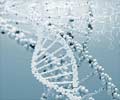According to scientists gene therapy can be performed safely in the human salivary gland.

These initial results clear the way for additional gene therapy studies in the salivary glands. Although sometimes overlooked, salivary glands present an ideal target for gene therapy. They are easily accessible and, once a gene is introduced, it has no obvious escape route into the bloodstream, where it can have unintended consequences.
"You cannot imagine how fulfilling it is to jot down an idea on a napkin in 1991 and then see it enter a clinical trial and help people.," said Bruce Baum, D.M.D., Ph.D., lead author on the study and recently retired NIDCR scientist who spent the last 21 years moving gene therapy in the salivary glands from the research bench to the clinic. "Can a scientist ask for anything better?"
Baum's interest in helping head and neck cancer survivors dates to the early 1980s. While attending to patients in the NIDCR's Dry Mouth Clinic, Baum encountered numerous people with head and neck cancer who had received radiation therapy to shrink their tumors. The radiation, while effective in treating cancer, had inadvertently damaged nearby salivary glands, compromising their ability to secrete saliva into the mouth.
Baum said he was thoroughly frustrated at the time because he had no effective moisture-restoring treatments to offer most patients. They had beaten cancer, but the radiation had left them with a permanent parched sensation in their mouths that diminished their quality of life and often led to chronic oral problems, such as difficulty swallowing, inflammation, infection, bad breath, and pain.
In the early 1990s, as the first gene-therapy studies entered research clinics, Baum saw an opportunity to make a difference. An initial napkin sketch of the procedure and 15 years of research later, Baum and his colleagues had assembled a compelling scientific case in animal studies that the transferred Aquaporin-1 gene, once expressed, will create new water channels in the impermeable salivary gland cells and allow water to flow through them. After rigorous reviews by NIH and the U. S. Food and Drug Administration, the Phase I protocol was launched and the first patients treated in 2008.
Advertisement
The scientists found that five participants had increased levels of saliva secretion, as well as a renewed sense of moisture and lubrication in their mouths, within the study's first 42 days, the period covered in this report. Of the six who didn't benefit from gene therapy, none had serious side effects. The most common side effect was a transient and relatively minor immune response against the disabled adenovirus.
Source-Eurekalert














